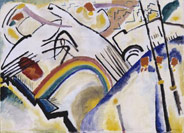Wassily Kandinsky
dal 21/6/2006 al 30/9/2006
Segnalato da
21/6/2006
Wassily Kandinsky
Tate Modern, London
Over 50 paintings and 30 works on paper. This exhibition follows Kandinsky’s intriguing journey from figurative landscape painter to modernist master, as he strove to develop a radically abstract language. Focusing on the first half of his career, the exhibition begins with a series of early landscapes inspired by the exquisite Bavarian countryside and folk imagery from Russian fairy tales and legends.

The Path to Abstraction 1908 - 1922
This will be the first major exhibition in the UK to focus on the paintings of Wassily Kandinsky (1866-1944), one of the most important figures in the evolution of abstraction. It will include around fifty-five paintings and a group of works on paper and will examine the period in Kandinsky's career spanning his time in Munich and Murnau in the second decade of the twentieth-century, his return to Moscow in 1914 and his departure from there in 1922 for Weimar via Berlin, where he accepted a teaching post at the Bauhaus.
During the first two decades of the twentieth-century, Kandinsky moved beyond observational work towards images generated by an inner vision. By reducing descriptive details and stripping away superfluous elements such as castles on hills or riders on horseback, he used calligraphic lines as structuring devices within his compositions.
With areas of bright colour and a dynamic and lyrical network of these lines, he created his mobility and movement in his work and frequently made reference to the free-flowing emotions associated with music and the values attached to specific colours. The intense subjectivity of the work is one of the hallmarks of Expressionism and, in particular, one of the key concerns of the Blue Rider group, which Kandinsky co-founded with Franz Marc and Alexei Jawlensky in 1911. A series of major works entitled Compositions gave this exploration its fullest expression.
When the First World War broke out in 1914, Kandinsky returned to Russia where he soon became involved with the artistic activities of the fledgling Soviet State. His paintings, after a short-lived return to figuration in a rococo style, gradually evolved towards a more centred, contained and linear expression in response to the work of other artists such as Malevich and Lissitzky whose work he encountered there.
Like many of those artists, among them Naum Gabo, Kandinsky became disenchanted with an increasing political control over artistic expression and left Russia for Berlin in 1921. Early the following year he was invited to join the Bauhaus. The flowing forms and bright colours of his work up to that point gave way to a rich, though more muted, palette, and his forms crystallised into ordered, geometrical structures. The onset of this new way of painting forms the end point of this exhibition in works such as Circles on Black (1921).
The exhibition has been co-selected by Tate Curator Sean Rainbird, for Tate Modern and Hartwig Fischer, Curator, for Kunstmuseum Basel. It will be accompanied by a full colour, illustrated catalogue with contributions from Shulamith Behr, Bruno Haas, Noemi Smolik and Reinhard Zimmermann.
The exhibition will go on display at Kunstmuseum, Basel from 21 October 2006 to
4 February 2007.
For information please call +44 (0) 20 7887 8888
Supported by Tate Members
Additional support from Access Industries
Tate Modern, Level 4
Press View: 20 June
Tate Modern
Bankside - London
Opening hours: every day from 10.00 - 18.00 and late night until 22.00 on Friday and Saturday
Admission: £10, Concessions £8



